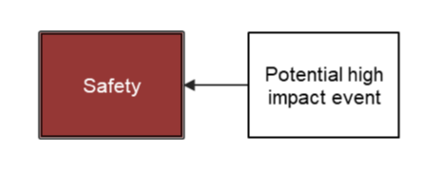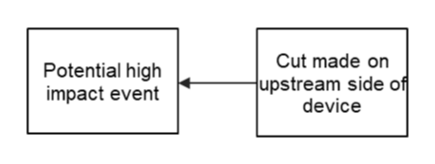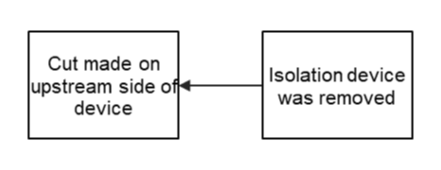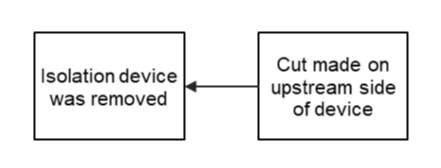As a ThinkReliability instructor and facilitator, very often I get the questions, "Where does this cause go?" or similarly, "Where does this cause fit in?" Then begins a discussion to find the most accurate location on a Cause Map. Please notice that I did not use the phrase, "the right location.” You are striving for an accurate and clear map of the incident.
This does not need to be a lengthy discussion. One technique I use is to simply look at a causal pair and ask the question, “Does this pair make sense?” To show the thought process visually, we will start with the map below, and break it down into individual causal pairs:

Using the full example above we will now focus on each pair. First is the Impact to the Safety goal:

As this is taken directly from the Outline of the problem, we are starting on solid ground, and we can confidently state that the potential high impact event (aka a near miss) caused an Impact to Safety.
Now, let’s move to the next pair in the series:

When we read this pair, the logic still works – cutting on the wrong side of a device could lead to a high impact event.
So far, so good. Let’s check the next cause and effect pair:

When we apply the logic to this pair, we can see that the relationship does not make sense. Removing the isolation valve does not cause the cut to be on the wrong side of the valve. It is more accurate the other way around.
 The cut being made on the wrong side of the isolation device is one of the causes that led to the isolation device being removed. Updating the relationship results in what you see below:
The cut being made on the wrong side of the isolation device is one of the causes that led to the isolation device being removed. Updating the relationship results in what you see below:
 Now we have an accurate starting picture of this part of the Cause Map. The technique can then be applied as a quality check to assist with the overall construction of the Cause Map.
Now we have an accurate starting picture of this part of the Cause Map. The technique can then be applied as a quality check to assist with the overall construction of the Cause Map.
Sometimes the logic we have discussed above can work both ways! When that occurs, it is a clear sign of the need to understand the exact meaning behind the cause. Most often you will find that there are underlying differences implied in each position that are not always clear at first. Detail will be your friend. I encourage you to check out Ely Wilson’s blog on the Chicken and the Egg. Ely speaks to adding detail to your Cause Map.










